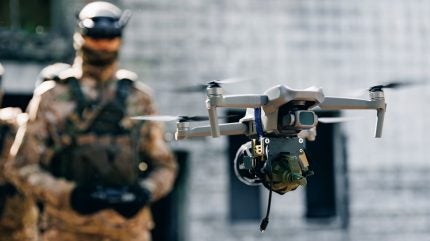
Following two and a half years of conflict, one of the major impacts of Russia’s invasion of Ukraine has been the rising deployment of drones and the evolution of counter-drone technologies, underlining the crucial role of Counter-Unmanned Aerial Systems (C-UAS) in modern warfare.
The proliferation of drones on the battlefield is forcing military leaders to consider how to deal with this threat in the most effective and cost-effective way. With drones able to destroy expensive equipment and take lives, military leaders are exploring technologies that combine detection, tracking, and mitigation to stop the deadly influx. These technologies include passive techniques like jamming and cyberwarfare, and active techniques using traditional canon and missile-based approaches as well as high energy laser weapons, electro-magnetic pulse weapons, interceptors and nets to destroy drones.
As the drone landscape continues to evolve, defence contractors and strategic thinkers are increasingly investing in counter-drone technologies, leading to a rapid expansion of markets for both drones and C-UAS.
Demand is rising for UAVs
According to GlobalData’s Defence Platform Acquisition database, the global military Unmanned Aerial Vehicles (UAV) market is projected to see robust growth in both value and volume over the next decade. In 2024, the market was valued at approximately 12 billion dollars with a total volume of 17 thousand units.
The effectiveness of lower-cost UAS has been demonstrated in the conflict in Ukraine, where Ukrainian forces have been observed utilising commercial off-the-shelf drones and low-cost unmanned technologies in military operations. Tactics have included the arming of cheap UAVs to deploy grenades and mortar rounds, raising concerns about the detection of such UAVs and creating an increased demand for C-UAS systems.
Another key driver of the UAV trend is their growing threat to vessels at sea. Currently, these vessels are using high-cost missiles to protect themselves and defeat drones, but following recent incidents in the Red Sea and Black Sea there is an increasing demand to protect them with low-cost counter-UAV solutions such as remotely controlled weapons stations and high energy laser systems.
As the global defence scene changes, the role of UAS and C-UAS will remain critical, but how nations employ cutting-edge UAS technology to defend against new threats will depend on their defence resources.
Counter-drone technologies
Ukraine is actively working to upgrade its defence capabilities and boost international collaboration, with the switch to direct contracts with arms manufacturers reducing its reliance on intermediaries.
Meanwhile, the Ministry of Defence of Ukraine has stated that the country is interested in developing technologies for integrating weapon systems into land and maritime platforms to provide new solutions for countering threats.
To this end, technology manufactured by Canberra-based Australian defence company, Electro Optic Systems (EOS) has been sent to Ukraine as part of a US security assistance package. This includes the 30mm Slinger counter-drone weapon system, which contains radar, 30mm stabilised cannon with proximity-fuse, and high explosive ammunition designed for tracking and drone engagement at a range of more than 800 metres.
This innovative approach to counter-drone technology, combining advanced software, precise targeting, and versatile weapon options, sets it apart as a leading solution in the field.
The EOS Slinger weapon system features a state-of-the-art fire control system, advanced algorithms for target detection and tracking, and a fully stabilised four-axis gimbal for precise pointing on the move. A modular design allows for easy integration with existing platforms, rapid battle damage repair, and it can accommodate various weapon types, including machine guns, cannons, rockets and missiles.
EOS is also actively working with artificial intelligence (AI) companies to automate target identification. For example, the Slinger – when integrated into a Battlespace Management System – quickly gains the Recognised Air Picture from native sensors within the battlegroup. The company is also moving into wireless versions for deployment on uncrewed ground vehicles (UGVs), and is increasingly integrating with rockets and missiles, offering greater range and targeting capabilities.
Low-cost solutions for Ukraine
A huge advantage of the Slinger is its cost, priced at less than US $1 million (AUS $1.5 million) per system – with a per engagement cost of around $100 to $1,000 depending on the type of ammunition. As Ukrainian cities are being attacked daily by drones and missiles, the system is providing a much-needed solution against moving targets, especially drones, and is quick and easy to learn to use.
On a visit last year to EOS, Ukraine’s ambassador to Australia, Vasyl Myroshnychenko, saw first-hand how Slinger can bring down drones for a fraction of the cost of missiles, while watching a test run.
“Sometimes those missiles cost millions. And you hit the drones, which cost $2,000…it’s all about the cost,” Mr Myroshnychenko said during the visit. The Ukrainian ambassador also emphasised the importance of the Slinger system in addressing the ongoing threat posed by drones and missiles.
In July this year, members of the Ukrainian defence leadership met with Australian defence industry representatives to expand international cooperation and military capabilities. Ukraine’s Deputy Minister of Defence, Dmytro Klimenkov, also met with EOS to discuss technology and potential collaboration opportunities. Klimenkov said: “Ukraine continues to work actively to modernise its defence capabilities and expand international cooperation…your assistance is crucial for us in these difficult times. We appreciate the solidarity and support provided by the Australian people.”
To find out more, download the free paper below.


